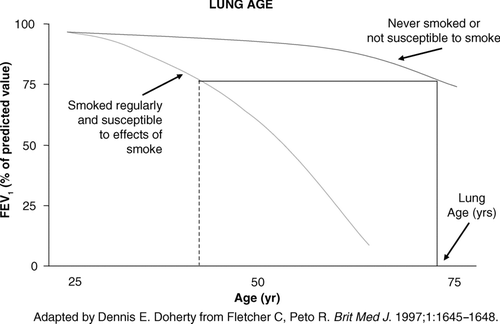Figures & data
Table 1 Clinical variations between COPD and asthma
Figure 1A Source (Citation[36]), permission to reproduce required. “Risks” for various men if they smoke: differences between these lines illustrate effects that smoking, and stopping smoking, can have on FEV1 in those men who are liable to develop chronic obstructive lung disease if they smoke. “Death” indicates deaths whose underlying cause is irreversible chronic obstructive lung disease, whether the immediate cause of death is respiratory failure, pneumonia, cor pulmonale, or aggravation of other heart disease by respiratory insufficiency. [These data are the composite of several individuals measured at various times (cross-sectional) and not following patients over several years (not longitudinal)]. Although this shows rate of loss of FEV, for one particular susceptible smoker, other susceptible smokers will have different rates of loss, thus reaching ‘disability’ at different ages” (Citation[36]).
![Figure 1A Source (Citation[36]), permission to reproduce required. “Risks” for various men if they smoke: differences between these lines illustrate effects that smoking, and stopping smoking, can have on FEV1 in those men who are liable to develop chronic obstructive lung disease if they smoke. “Death” indicates deaths whose underlying cause is irreversible chronic obstructive lung disease, whether the immediate cause of death is respiratory failure, pneumonia, cor pulmonale, or aggravation of other heart disease by respiratory insufficiency. [These data are the composite of several individuals measured at various times (cross-sectional) and not following patients over several years (not longitudinal)]. Although this shows rate of loss of FEV, for one particular susceptible smoker, other susceptible smokers will have different rates of loss, thus reaching ‘disability’ at different ages” (Citation[36]).](/cms/asset/fcbc5e92-fbba-41de-ae26-bcde8af576b1/icop_a_336505_uf0001_b.gif)
Figure 1B The upper dotted line represents the normal decline in those who have not smoked, or in smokers who are not susceptible to the effects of tobacco smoke on lung function decline. The lower dashed line represents an accelerated loss of lung function over time in those ‘susceptible’ smokers. The FEV1 a susceptible 40 year old smoker was measured at 75% predicted (dotted vertical line). If one extrapolates that level of lung function of this susceptible individual (draw a horizontal line to the curve of a never smoker or one not susceptible to smoking), their ‘Lung Age’ is approximately 74 – equivalent lung function to that of a never smoker (or non-susceptible smoker) when they are 74.

Table 2 Variables and point values used for the computation of the BODE index